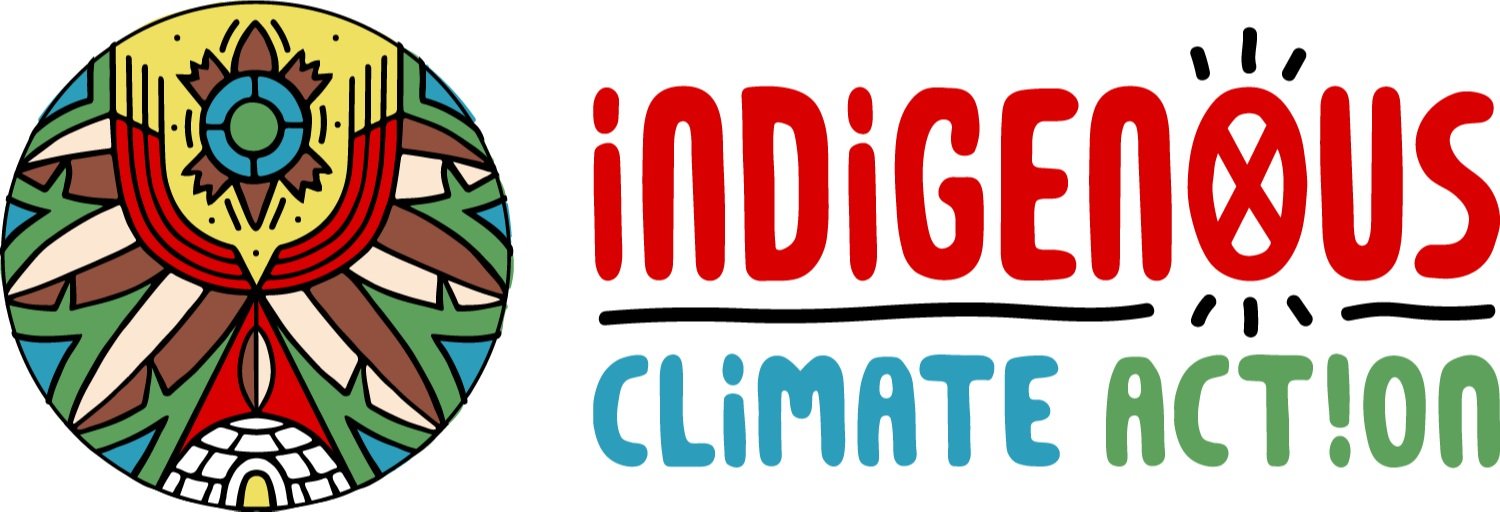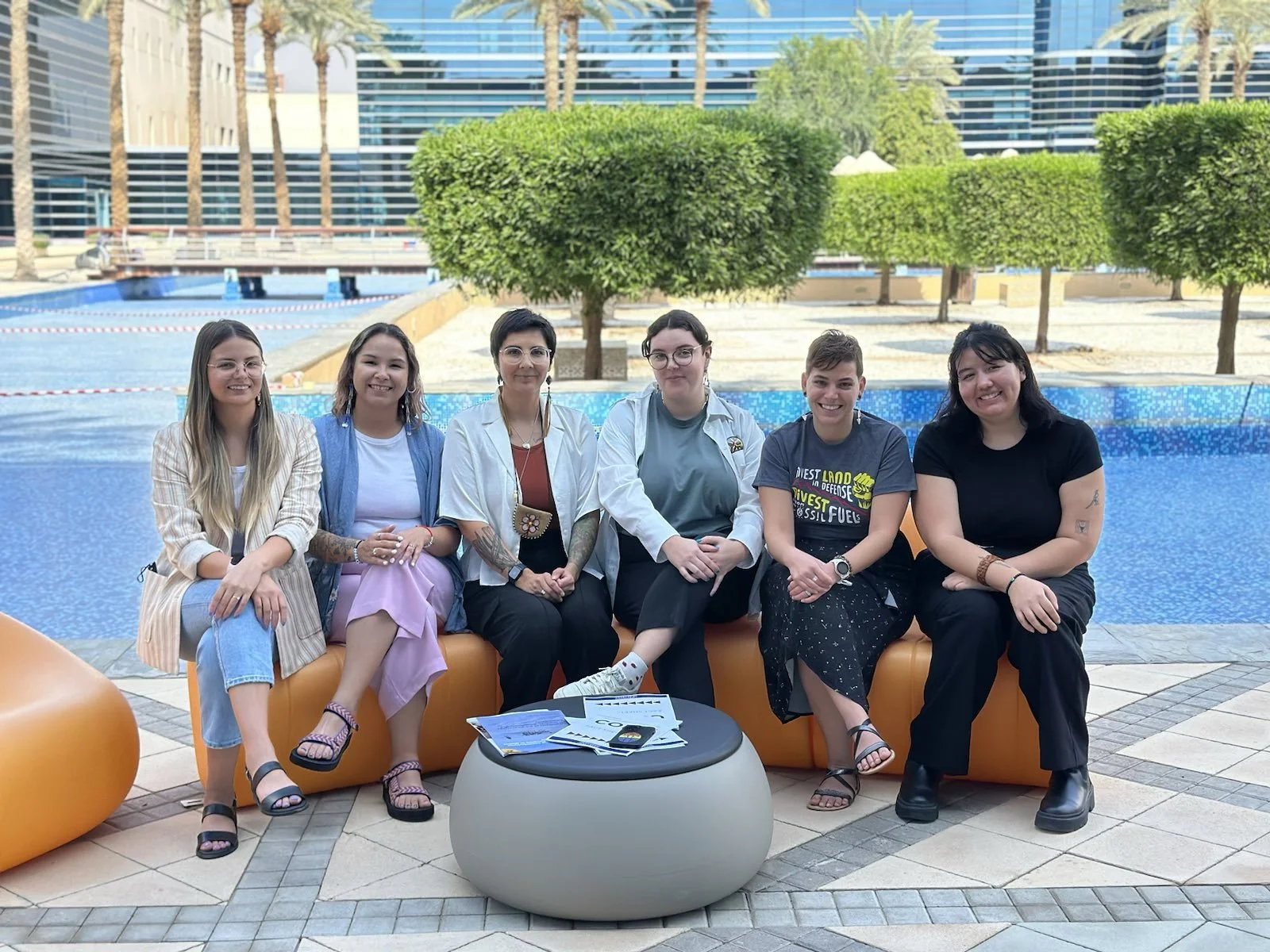Carole Monture Reflects on COP28
ICA COP28 Delegates attend preparatory meetings with International Indigenous Peoples Caucus.
Prior to my work with ICA, I was unaware of the United Nations Framework Convention on Climate Change (UNFCCC) process. Even while I was a part of the team I still felt dismissive of the entire thing and while that sentiment has shifted there are still legitimate criticisms to be made. I am younger than the COP process itself and have lived the entirety of my life with the effects of climate change and at the same time witnessed political leaders and institutions such as the UNFCCC fail to deliver meaningful climate action at the scale needed to truly address the climate crisis.
As such, I did not see the value in attending the Conference of the Parties (COP) and understand why others may feel the same, particularly when our communities are already leading climate solutions. It wasn't until I began to learn more about carbon market schemes and other false solutions and how they are being promoted by governments and in forums such as the UNFCCC that I began to shift my perspective and saw the necessity for Indigenous people to participate and assert our inherent rights at the highest level, including at the UNFCCC COP.
Through my work in the Climate Leadership Program many of our participants have questions about COP: how it works, what are the outcomes, why ICA attends, and how they can get involved. I wanted to be better equipped to explain these processes and the value of participating to my communities both through work and at home. While I didn’t fully know what to expect at my first COP, I knew it would be a good opportunity to grow knowledge of the UNFCCC process to bring that knowledge back home to my community.
The COP Experience
Carole at the Global March for Climate Justice and Ceasfire Now.
After two days of preparatory meetings for the Indigenous Peoples caucus, our delegation hit the ground running. This COP was the most attended ever in the largest venue ever. I thought I had prepared myself for the intensity, fast pace, and long days but it was still somewhat of a shock to me. After the first couple of days, I began to settle into a routine. Our delegation held a morning meeting over breakfast. We would all take a shuttle to the venue where we would go through airport-level security to enter the blue zone, scan our badges for entry, and then attend the daily meeting for the Indigenous Peoples’ caucus meeting. I personally spoke at two press conferences, and two side events, participated in the launch of the official youth caucus under the Indigenous people’s caucus, and attended several actions during my time at COP.
Two of the most impactful actions I attended were a ceasefire march on December 3rd in solidarity with our Palestinian relatives and the December 9th Global March for Climate Justice and Ceasefire Now where hundreds of people across different constituencies marched in the blue zone to demand climate justice and a ceasefire in Gaza. All throughout COP there was clear solidarity with Palestine and demand for a permanent ceasefire. On the very first day of COP, the Indigenous Peoples’ caucus issued a statement calling for a ceasefire and making it very clear that we cannot achieve true climate justice without a resolution to the occupation of Palestine.
Shifting Perspectives
For the first week of the COP, I largely attended side events and actions. These were valuable learning opportunities to understand the impacts of climate change and strengthen connections with our networks and allies.
While attending the Indigenous Peoples caucus I began to understand the COP process more. During the daily meeting members of the caucus provide updates on the negotiations that are being followed by the different working groups. In previous years most of my awareness of COP came through coverage of the side events. It wasn’t until I was on the ground that I began to learn how the Indigenous peoples' constituency functioned within the UNFCCC. The International Work Group for Indigenous Affairs (IGWIA) explains that “the Indigenous Peoples’ constituency is organized in the International Indigenous Peoples’ Forum on Climate Change (IIPFCC) which serves as a caucus and mechanism for developing common positions and statements of Indigenous Peoples, and for undertaking effective strategies, lobbying, and advocacy work at UNFCCC meetings and sessions.“ During the second week, I began to follow Article 6 negotiations, sitting in on some of the negotiations both in person and via webcast.
Carole speaks at Demand Climate Justice Press Conference.
“As a proud Haudenosaunee, I was conflicted about carrying a badge from a country that I don’t consider myself a citizen of, while also feeling an obligation to attend for those who couldn’t.”
Often when negotiations are getting down to the wire the negotiators will “huddle” and talk only amongst themselves away from microphones or interpretation or negotiations will be “closed door” - not shown via webcast and only allow pink party badge holders. Those with yellow civil society badges are completely excluded from attending these negotiations. It is often challenging to obtain accreditation and Indigenous Peoples have to choose between receiving a party badge from their home country which can be difficult to navigate, or to receive a yellow badge which is more restrictive. A yellow badge can mean Indigenous Peoples are not even permitted to observe negotiations which will directly impact their rights. I happened to hold a pink party overflow badge because I spoke on a panel at the Canadian Pavillion. As a proud Haudenosaunee, I was conflicted about carrying a badge from a country that I don’t consider myself a citizen of, while also feeling an obligation to attend for those who couldn’t.
In a negotiation I attended for Article 6.4 parties debated back and forth for an hour the difference between “shall'' and “should” in one singular paragraph. While this is tedious to listen to, it is an important distinction. Negotiations will sometimes continue well into the evening and early mornings for this reason. I also learned that much of the text for negotiations is drafted months before the COP during one of two subsidiary bodies: the Subsidiary Body for Scientific & Technological Advice (SBSTA) as well as the Subsidiary Body for Implementation. If the negotiators can’t come to a consensus during COP that text gets tabled and revised during the next SBSTA. Without even going into much detail you can see how these processes are bureaucratic and intentionally difficult to navigate which makes it even more important for Indigenous Peoples to get involved and hold these bodies and processes accountable.
Indigenous Participation
Indigenous people need to participate in the UNFCCC because our knowledge systems are critical to developing solutions to the climate crisis. There is currently no other forum that allows us to make high-level climate policy interventions and through participation in the Indigenous Peoples’ caucus and the working groups our people can put forth language that goes into the negotiations.
“There is currently no other forum that allows us to make high-level climate policy interventions…I am not undermining or devaluing the importance of grassroots, community-led climate solutions. Participating in the UNFCCC is simply a tool in the toolbox of global climate action.”
While I believe in the importance of participating in the UNFCCC process, I am not undermining or devaluing the importance of grassroots, community-led climate solutions. Participating in the UNFCCC is simply a tool in the toolbox of global climate action. We need Indigenous people leading climate solutions at every level of society, including at the highest levels at the UNFCCC. I believe that grassroots and international policy work are not opposed but rather inform each other. Community work grounds you and reminds you of what’s really important and what you’re fighting for while you’re attending forums such as COP. In turn, international policy informs what we can achieve at home on the grassroots level and provides an opportunity to share knowledge with our communities about the UNFCCC and how it impacts our rights.
In the future, I would love to see ICA’s delegation grow and be able to support more Indigenous people from North America, particularly young people to participate and collaborate with the global Indigenous Peoples movement. I believe that a global movement of Indigenous Peoples is one of the best ways to bring about climate action. While the final text of the COP28 negotiations may seem “historic” - for the first time ever making specific mention the need to transition away from fossil fuels - in reality, they are still full of loopholes. Loopholes that continue to ignore the climate crisis we are in and continue a business-as-usual approach that prioritizes corporate profit over a fossil fuel phase-out, a Just Transition to renewable energy, and uphold the inherent rights of Indigenous Peoples.
We, as Indigenous people at the UNFCCC and at home, continue to lead effective climate solutions by fulfilling our original instructions, stewarding our homelands, and keeping carbon in the ground.
About the Author
Carole Monture (she/her) is Kanienkehá:ka (Mohawk) Wolf Clan from Six Nations of the Grand River territory where she lives with her family. She volunteers with Protect the Tract - a Haudenosaunnee-led project that conducts research, policy development, and develops capacity for civil engagement, to exercise sovereignty through the promotion of land stewardship over the Haldimand Tract. In her role at ICA as Climate Leadership Coordinator Carole feels honoured to work alongside Indigenous communities through the Climate Leadership Program as they explore the root causes of climate change and work towards real solutions guided by their cultures and ways of knowing.




